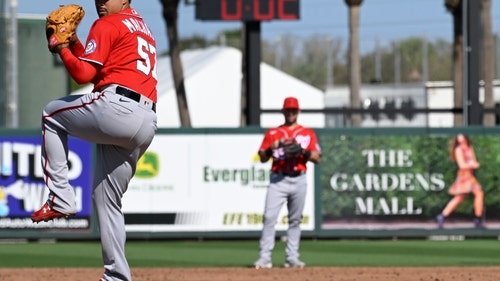
Demographic breakdown of recent Tommy John surgeries

Epidemics often lead to hysteria.
Baseball’s wave of Tommy John surgeries might not qualify as an epidemic. The reaction might not qualify as hysteria. But Stan Conte, the Dodgers head athletic trainer and part of MLB’s effort to research arm injuries, wants to correct some growing misconceptions.
The latest misconception, Conte told Fox Sports on Wednesday, is that pitchers born in the United States undergo Tommy John surgery at a higher rate than pitchers from the Dominican Republic and other Latin American countries.
While some contend that the rigors of youth baseball in the US place American-born pitchers at higher risk for torn elbow ligaments, Conte was part of a research team that found no difference in the prevalence of Tommy John surgery based upon where pitchers were born.
Conte said that the research team included Dr. Glen Fleisig, research director of the American Sports Medicine Institute; Dr. Kevin Wilk, a noted physical therapist, and Dr. Neal ElAttrache, a sports medicine surgeon and member of the Kerlan-Jobe Orthopaedic Clinic Board of Directors.
The team’s survey of 40-man roster players in 2013 and non-40-man roster players in 2012 was intended to provide a snapshot of how many players had undergone Tommy John surgery, not in a given year, but over their careers.
A total of 5,088 players responded, an estimated 89 percent of the possible total. Of the respondents, 14.2 percent were major leaguers. Pitchers represented 53 percent of the total, major-league pitchers 7.5 percent.
And what did the researchers find?
That 16 percent of pitchers from the US had undergone Tommy John surgery – as had 16 percent of pitchers from the Dominican, and 16 percent from all Latin American countries.
“We saw no difference,” Conte said. “At the end of the day, when you look at who has had Tommy John surgeries, country doesn’t seem to have a significant importance.
“Whether they come from the Dominican or the United States, it looks like they’re all kind of getting it at some point – overall, major and minor leagues, about 16 percent.”
Conte said that he did not necessarily disagree that the intensity of youth baseball in the US contributes to a large number of elbow injuries for pitchers. But international pitchers also face pressure at young ages to land contracts from major-league clubs, perhaps leading them to place greater strain on their arms.
An international player can sign when he is 16 during the signing period that extends from July 2 through June 15 of the following year if the prospect turns 17 before Sept. 1 or by the completion of his first minor-league season.
The researchers, in trying to pinpoint when pitchers underwent Tommy John surgery, found that a much larger percentage of Dominican and Latin American pitchers had their first TJ at the professional level than US pitchers.
For all groups, however, the average age of the first surgery was 21. About half of the American pro pitchers were still in school near the age of their surgery. Almost all of the Latin American pitchers already were professional.
Conte and his team are working as part of a larger group headed by Dr. Gary Green, MLB’s medical director. The group is trying to determine the causes of elbow and other arm injuries. Green told Fox Sports last week that he did not expect to find “a magic bullet,” an overriding solution to a multi-faceted problem.
“People say we should do something,” Conte said. “We are doing something. This research is two years old. We’ve been doing these things. And we’ve been trying to answer these questions. But we can’t have a knee-jerk reaction (when we) find something, run out and tell everybody and then maybe find out, ‘Oh, that wasn’t true.’”
Conte said another misconception stems from media reports citing research from Dr. James Andrews that pegged the average recovery time from Tommy John surgery at 11.6 months.
Andrews’ research included high school, college and professional pitchers, Conte said. The average major leaguer, trying to return to the highest level of the sport, faces a longer recovery.
“How easier is it to get a college freshman back to playing college baseball after a Tommy John?” Conte asked. “Probably a little easier than getting one of these (major leaguers) out to perform at this level. If a college guy degrades by 5 or 6 percent, it’s not as big a deal. Five or 6 percent here? He goes home.”
Conte said he researched 212 Tommy John surgeries performed on major leaguers from 2000 to ’12 in an effort to determine the success rate of the procedure and how long it took the pitchers to recover.
Of the 212, he said, 161 returned to throw at least one major-league inning – a success rate of 75.9 percent. Determining the average rate of return was tricky, however; pitchers who undergo the surgery after June do not always make it back the following year, and then must wait an entire offseason to resume their careers.
Including those pitchers, the average rate of return was 18 months, and the median was 14.8 months, Conte said.
“Part of this myth is that this is 100 percent successful and you come back in 12 months on the dot and you perform better, at better velocity than you did before,” Conte said. “Some of that is true. There are guys who do that. But what about the average guy? That’s what we’re looking at.”
Conte said he wants baseball to use objective methodology in its medical research, something the sport routinely does now in player evaluation.
The subject, he said, is too important to base conclusions on subjectivity and supposition.
“We have to get our facts together,” Conte said. “We have to look at it from an objective standpoint. It can’t be anecdotal. It can’t be that Tim Hudson came back in 11 months. It’s got to be the numbers.
“We’re in a society where you want an answer right away, you want a knee-jerk reaction and you want to fix something within the next 20 seconds. That’s a formula for disaster and going down the wrong path.
“We need to go through some scientific exploration to get those answers. And then we need people in baseball to be smart enough to take those answers and transfer them into what is happening on a day-to-day basis.”










